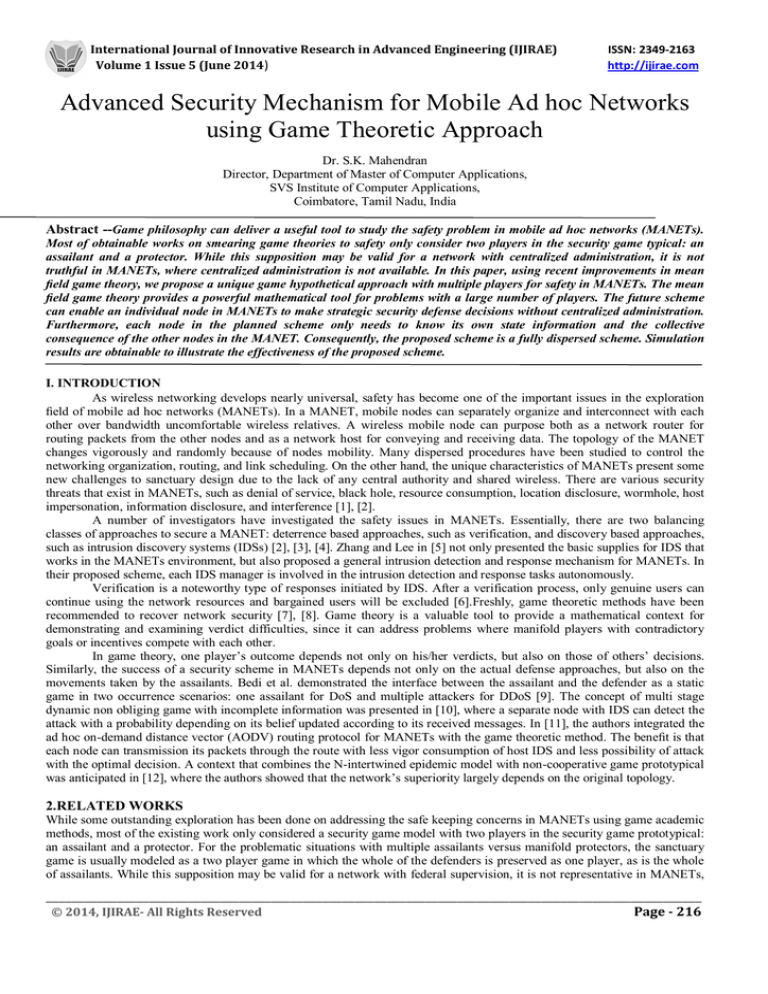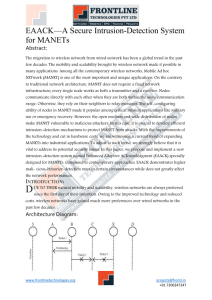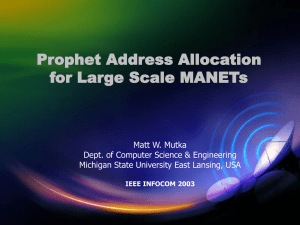
International Journal of Innovative Research in Advanced Engineering (IJIRAE)
Volume 1 Issue 5 (June 2014)
ISSN: 2349-2163
http://ijirae.com
Advanced Security Mechanism for Mobile Ad hoc Networks
using Game Theoretic Approach
Dr. S.K. Mahendran
Director, Department of Master of Computer Applications,
SVS Institute of Computer Applications,
Coimbatore, Tamil Nadu, India
Abstract --Game philosophy can deliver a useful tool to study the safety problem in mobile ad hoc networks (MANETs).
Most of obtainable works on smearing game theories to safety only consider two players in the security game typical: an
assailant and a protector. While this supposition may be valid for a network with centralized administration, it is not
truthful in MANETs, where centralized administration is not available. In this paper, using recent improvements in mean
field game theory, we propose a unique game hypothetical approach with multiple players for safety in MANETs. The mean
field game theory provides a powerful mathematical tool for problems with a large number of players. The future scheme
can enable an individual node in MANETs to make strategic security defense decisions without centralized administration.
Furthermore, each node in the planned scheme only needs to know its own state information and the collective
consequence of the other nodes in the MANET. Consequently, the proposed scheme is a fully dispersed scheme. Simulation
results are obtainable to illustrate the effectiveness of the proposed scheme.
I. INTRODUCTION
As wireless networking develops nearly universal, safety has become one of the important issues in the exploration
field of mobile ad hoc networks (MANETs). In a MANET, mobile nodes can separately organize and interconnect with each
other over bandwidth uncomfortable wireless relatives. A wireless mobile node can purpose both as a network router for
routing packets from the other nodes and as a network host for conveying and receiving data. The topology of the MANET
changes vigorously and randomly because of nodes mobility. Many dispersed procedures have been studied to control the
networking organization, routing, and link scheduling. On the other hand, the unique characteristics of MANETs present some
new challenges to sanctuary design due to the lack of any central authority and shared wireless. There are various security
threats that exist in MANETs, such as denial of service, black hole, resource consumption, location disclosure, wormhole, host
impersonation, information disclosure, and interference [1], [2].
A number of investigators have investigated the safety issues in MANETs. Essentially, there are two balancing
classes of approaches to secure a MANET: deterrence based approaches, such as verification, and discovery based approaches,
such as intrusion discovery systems (IDSs) [2], [3], [4]. Zhang and Lee in [5] not only presented the basic supplies for IDS that
works in the MANETs environment, but also proposed a general intrusion detection and response mechanism for MANETs. In
their proposed scheme, each IDS manager is involved in the intrusion detection and response tasks autonomously.
Verification is a noteworthy type of responses initiated by IDS. After a verification process, only genuine users can
continue using the network resources and bargained users will be excluded [6].Freshly, game theoretic methods have been
recommended to recover network security [7], [8]. Game theory is a valuable tool to provide a mathematical context for
demonstrating and examining verdict difficulties, since it can address problems where manifold players with contradictory
goals or incentives compete with each other.
In game theory, one player’s outcome depends not only on his/her verdicts, but also on those of others’ decisions.
Similarly, the success of a security scheme in MANETs depends not only on the actual defense approaches, but also on the
movements taken by the assailants. Bedi et al. demonstrated the interface between the assailant and the defender as a static
game in two occurrence scenarios: one assailant for DoS and multiple attackers for DDoS [9]. The concept of multi stage
dynamic non obliging game with incomplete information was presented in [10], where a separate node with IDS can detect the
attack with a probability depending on its belief updated according to its received messages. In [11], the authors integrated the
ad hoc on-demand distance vector (AODV) routing protocol for MANETs with the game theoretic method. The benefit is that
each node can transmission its packets through the route with less vigor consumption of host IDS and less possibility of attack
with the optimal decision. A context that combines the N-intertwined epidemic model with non-cooperative game prototypical
was anticipated in [12], where the authors showed that the network’s superiority largely depends on the original topology.
2.RELATED WORKS
While some outstanding exploration has been done on addressing the safe keeping concerns in MANETs using game academic
methods, most of the existing work only considered a security game model with two players in the security game prototypical:
an assailant and a protector. For the problematic situations with multiple assailants versus manifold protectors, the sanctuary
game is usually modeled as a two player game in which the whole of the defenders is preserved as one player, as is the whole
of assailants. While this supposition may be valid for a network with federal supervision, it is not representative in MANETs,
______________________________________________________________________________________________________
© 2014, IJIRAE- All Rights Reserved
Page - 216
International Journal of Innovative Research in Advanced Engineering (IJIRAE)
Volume 1 Issue 5 (June 2014)
ISSN: 2349-2163
http://ijirae.com
where federal administration is not available. Accordingly, each separate node in a MANET should be treated distinctly in the
security game model.
Fig. 1. A N-node MANET with an attacker
In this paper, using recent developments in mean field game theory [14], we recommend a novel game theoretic
approach for security in MANETs. The mean field game theory provides a powerful mathematical tool for problems with a
large number of players. It has been successfully used by economists, collectivists, and contrives in different areas, among
others [15]. In communication networks, several researchers have tried to use mean field estimate method and mean field game
philosophies to solve the energy efficiency and medium access control [13] problems. To the best of our information, using
mean field game hypothetical approach for safety in MANETs has not been considered in the existing works. The contributions
of this work are as follows.
3. PROPOSED WORK
We propose a Dynamic Field Game Approach (DFGA) to enable an individual node in MANETs to make strategic
security defense decisions without centralized administration. Since safety defense mechanisms in a wireless mobile node
consume precious system resources (e.g., energy), the proposed scheme considers not only the security requirement of
MANETs but also the system resources. In the proposed mean field game hypothetical approach, each node only needs to
know its own state information and the collective effect of the other nodes in the MANET. Accordingly, the anticipated
scheme is a fully distributed arrangement. I-node MANET and an attacker are obtainable. Then the security problem of this
system is formulated as and I +1 mean field game. The genuine nodes are independent because there is no centralized
administration in the MANET.
When the attacker has successfully attacked the MANET, some rewards (e.g., secret information) can be acquired by
the attacker from the MANET. If the attacker failed because of the target node introduction the defense action, some rewards
(e.g., attack information) will be given to the target MANET node for its successful defense. Furthermore, the assailant and the
protectors all need to pay the cost (e.g., energy feasting) for their individual actions. We model this scheme as an i+1 mean
field game model as follows. We deliberate the defending MANET nodes as the N minor players. The foremost player’s state
is defined as a combination of vigor and information assets, which can be denoted by∝
+∝
.Meanwhile, the minor
players’ state is defined as a combination of energy and security assets, which is denoted by∝
+∝
.
When one state is “full vitality” and the key thespian could select the deed to strongly attack the whole network. As a
result, the energy cost is much higher than the one when the state is “deprived vitality” and the foremost player does not
occurrence. We define the instantaneous cost of the major player as follows:
( (x), (x), ( ) (x))
( )
(x))must also represent the regular reflection of the whole mean field to the major player’s bout.
In MANETs, it is difficult to unswervingly and sharp obtain ( ) (x))which represents the typical state of all the
inconsequential players, due to the dynamic changing topology and the lack of centralized administration. To overcome the
fundamental complexity and method can remain used to estimate the random ration process ( ) (x)) with a limiting process. In
MANETs, that the random process’s update is driven by the attacker’s current state and the current average state of MANETs.
We assume the minor player has two states. The limiting process ( )should contain two vectors: ( ) = { ( ), (x).The
setup of the above nodes’ transition matrices and cost matrices below can be done as follows. In constructing these values, we
______________________________________________________________________________________________________
© 2014, IJIRAE- All Rights Reserved
Page - 217
International Journal of Innovative Research in Advanced Engineering (IJIRAE)
Volume 1 Issue 5 (June 2014)
ISSN: 2349-2163
http://ijirae.com
assume that most node properties can be made known, which should be realistic particularly for MANETs where initial
planning and device management is an a priori requirement.
By “node properties” we mean the states and information that are used as input to the transition and cost matrices. If
these properties are not available, the matrices can be learned on-line when the system is running. We can see that, when the
state of the major player is negative attacking, the values of v are always below zero. The result also reflects that more attacks
may not produce more rewards, if the defenders’ successful detection rate is fixed. This is because the cost of occurrence may
be much sophisticated than the rewards for the major player. Throughout the game process, we consider the assailant always
runs with its optimal strategy, so we can obtain the assailant’s states by detecting its action here. These optimal state transition
laws can work well for the minor player, no matter which action the major player chooses. The average lifetime and the
negotiating probability of the MANET are also compared. We also consider the condition of the nodes in the MANET with
sufficient energy. The decrease of conceding probability and the improvement of lifetime using the optimal strategy are
depicted.
4. RESULTS AND DISCUSSION
The proposed protocol DFGA is simulated with NS2 simulator with the below settings and also compared with the AODV
protocol with the performance metrics packet delivery ratio, delay and throughput. Results show that DFGA outperforms better
in all the aspects than the AODV protocol. The settings used for the simulation are as below:
No. of Nodes
200
Terrain Size
100, 150, 200, 150
(in meters)
MAC
Radio
Transmission Range
Simulation Time
Traffic Source
Packet Size
Mobility Model
Initial Energy
Speed
802.11b
50 to 250 meters
100 seconds
CBR (Constant Bit Rate)
256 Kbits
Random Waypoint
Model
1 to 3 Joules
2.5 m/s
4.1 Packet Delivery Ratio
It is the ratio of the number of packets received successfully and the total number of packets transmitted
Fig.1: Transmission Range vs Packet Delivery Ratio
4.2 Throughput
Throughput is the ratio of number of packets sent and total number of packets.
______________________________________________________________________________________________________
© 2014, IJIRAE- All Rights Reserved
Page - 218
International Journal of Innovative Research in Advanced Engineering (IJIRAE)
Volume 1 Issue 5 (June 2014)
ISSN: 2349-2163
http://ijirae.com
Fig.2: Transmission Range vs Throughput
4.3 DELAY
The delay is averaged over all surviving data packets from the sources to the destinations.
Fig.3: Transmission Range vs Delay
4.4 Energy
It is the total power consumed by the node for the transferring of data from on node to another till it reaches the destination
Fig.4: Transmission Range vs Energy
5.CONCLUSION
In this paper, a novel field game theoretic methodology for security in MANETs is modeled for communications
among a malicious node and a large quantity of genuine MANET nodes. Unlike the existing works on security game modeling,
the proposed scheme can enable an individual node in MANETs to make distributed security defense pronouncements in all
aspects. Both security requirement and system resources were considered in the proposed organization. The simulation results
verified that, with the optimal strategy, the legitimate nodes can choose distributed actions intelligently to reduce their energy
ingesting and security value damage. The average generation of the MANET can be improved significantly and the
compromising probability can be reduced as well, that is with the performance metrics packet delivery ratio, throughput, delay
and energy. DFGA protocol played a vital role in securing the data from source and destination when compared to AODV and
also it outperforms in saving reducing the energy consuming. In our future work, we will extend our proposed scheme to the
scenario of multiple assailants and multiple defenders.
______________________________________________________________________________________________________
© 2014, IJIRAE- All Rights Reserved
Page - 219
International Journal of Innovative Research in Advanced Engineering (IJIRAE)
Volume 1 Issue 5 (June 2014)
ISSN: 2349-2163
http://ijirae.com
References
[1] H. Yang, H. Luo, F. Ye, S. Lu, and L. Zhang, “Security in mobile ad hoc networks: challenges and solutions,” IEEE Trans.
Wireless Commun., vol. 11, pp. 38–47, Feb. 2004.
[2] Q. Guan, F. R. Yu, S. Jiang, and V. Leung, “Joint topology control and authentication design in mobile ad hoc networks
with cooperative communications,” IEEE Trans. Veh. Technol., vol. 61, no. 6, pp. 2674– 2685, July 2012.
[3] Q. Guan, F. R. Yu, S. Jiang, and V. Leung, “Joint topology control and authentication design in mobile ad hoc networks
with cooperative communications,” IEEE Trans. Veh. Technol., vol. 61, no. 6, pp. 2674– 2685, July 2012. [4] J. Liu, F. R.
Yu, C.-H. Lung, and H. Tang, “Optimal combined intrusion detection and biometric-based continuous authentication in
high security mobile ad hoc networks,” IEEE Trans. Wireless Commun., vol. 8, no. 2, pp. 806–815, Feb. 2009.
[5] S. Bu, F. R. Yu, X. P. Liu, and H. Tang, “Structural results for combined continuous user authentication and intrusion
detection in high security mobile ad-hoc networks,” IEEE Trans. Wireless Commun., vol. 10, no. 9, pp. 3064–3073, Sept.
2011.
[6] Y. Zhang and W. Lee, “Intrusion detection in wireless ad hoc networks,” in Proc. 2000 ACM MOBICOM, pp. 275–283.
[7] T. Alpcan and T. Basar, Network Security: A Decision and Game Theoretic Approach. Cambridge University Press, 2010.
[8] X. Liang and Y. Xiao, “Game theory for network security,” IEEE Commun. Surveys Tuts., vol. 15, no. 1, pp. 472–486,
2013.
[9] H. Bedi, S. Roy, and S. Shiva, “Game theory-based defense mecha- nisms against ddos attacks on TCP/TCP-friendly
flows,” in Proc. 2011 Computational Intelligence Cyber Security, pp. 129–136.
[10] A. Patcha and J. M. Park, “A game theoretic formulation for intrusion detection in mobile ad hoc networks,” Int’l J. Netw.
Security, vol. 2, no. 2, pp. 131–137, 2006.
[11] E. A. Panaousis and C. Politis, “A game theoretic approach for securing AODV in emergency mobile ad hoc networks,”
in Proc. 2009 IEEE Conf. Local Comput. Netw., vol. 53, pp. 985–992.
[12] J. Omic, A. Orda, and P. Van Mieghem, “Protecting against network in- fections: a game theoretic perspective,” in Proc.
2009 IEEE INFOCOM, pp. 1485–1493
[13] M. Huang, P. Caines, and R. Malhame, “The NCE (mean field) principle with locality dependent cost interactions,” IEEE
Trans. Auto. Control, vol. 55, no. 12, pp. 2799–2805, Dec. 2010.
[14] M. Y. Huang, “Mean field stochastic games with discrete states and mixed players,” in Proc. 2012 GameNets. [15] F.
Meriaux, V. Varma, and S. Lasaulce, “Mean field energy games in wireless networks,” in Proc. 2012 Asilomar Conf.
Signals, Syst., Comput.
[16] H. Tembine, P. Vilanova, M. Assaad, and M. Debbah, “Mean field stochastic games for SINR-based medium access
control,” in Proc. 2011 Int’l ICST Conf. Performance Evaluation Methodologies Tools.
______________________________________________________________________________________________________
© 2014, IJIRAE- All Rights Reserved
Page - 220




